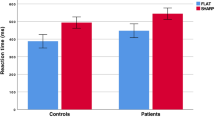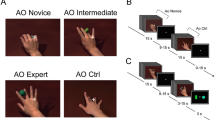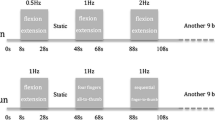Abstract
In the present report, we extend our previous observations on corticomotor facilitation associated with covert (action observed or imagined) and overt (action imitated) action execution in old adults (Leonard and Tremblay in Exp Brain Res 117:167–175, 2007) to investigate the impact of Parkinson’s disease (PD). Participants consisted of 22 older adults (age range 58–76 years) of whom 11 were medicated patients diagnosed with PD (patient group) and 11 were age-matched healthy controls (healthy group). Corticomotor facilitation was assessed by monitoring the changes in the amplitude of motor evoked potentials (MEP) in muscles of the right hand (first dorsal interosseous: FDI; and abductor digiti minimi: ADM) in response to transcranial magnetic stimulation of the left motor cortex. In each group, corticomotor facilitation was assessed with participants seated in front of a computer screen under four testing conditions: (1) REST: eyes closed and instructions to relax for 10 s, (2) OBS: observe action, (3) IMAG: imagine action and (4) IMIT: imitate action. The action depicted in the video displayed the hand of a male subject cutting a piece of material with scissors. Comparison of variations in MEP amplitude revealed a significant interaction between groups and conditions. In the healthy group, the OBS and IMAG conditions were both associated with significant facilitation in the FDI and ADM, whereas the same conditions failed to produce facilitation in the PD group. In both groups, the IMIT condition produced the largest facilitation in hand muscles. Further planned comparisons revealed a significant difference between groups in the FDI for the OBS condition. From these findings, we conclude that, even when properly medicated, old adults with PD may experience major difficulties in engaging the motor system for covert actions, particularly when asked to observe another person’s action. This failure of corticomotor facilitation for covert actions appears to be linked with the deficit in motor activation associated with basal ganglia dysfunction in PD and in line with the difficulty experienced in general by patients “to energize” the motor system in preparation for action.



Similar content being viewed by others
References
Amick MM, Schendan HE, Ganis G, Cronin-Golomb A (2006) Frontostriatal circuits are necessary for visuomotor transformation: mental rotation in Parkinson’s disease. Neuropsychologia 44:339–349
Aziz-Zadeh L, Iacoboni M, Zaidel E, Wilson S, Mazziotta J (2004) Left hemisphere motor facilitation in response to manual action sounds. Eur J Neurosci 19:2609–2612
Buhmann C, Glauche V, Sturenburg HJ, Oechsner M, Weiller C, Buchel C (2003) Pharmacologically modulated fMRI—cortical responsiveness to levodopa in drug-naive hemiparkinsonian patients. Brain 126:451–461
Chen R, Kumar S, Garg RR, Lang AE (2001) Impairment of motor cortex activation and deactivation in Parkinson’s disease. Clin Neurophysiol 112:600–607
Clark S, Tremblay F, Ste-Marie D (2004) Differential modulation of corticospinal excitability during observation, mental imagery and imitation of hand actions. Neuropsychologia 42:105–112
Cunnington R, Iansek R, Johnson KA, Bradshaw JL (1997) Movement-related potentials in Parkinson’s disease. Motor imagery and movement preparation. Brain 120:1339–1353
Cunnington R, Iansek R, Bradshaw JL (1999) Movement-related potentials in Parkinson’s disease: external cues and attentional strategies. Mov Disord 14:63–68
Cunnington R, Egan GF, O’Sullivan JD, Hughes AJ, Bradshaw JL, Colebatch JG (2001) Motor imagery in Parkinson’s disease: a PET study. Mov Disord 16:849–857
Decety J, Grezes J, Costes N, Perani D, Jeannerod M, Procyk E, Grassi F, Fazio F (1997) Brain activity during observation of actions. Influence of action content and subject’s strategy. Brain 120:1763–1777
Dechent P, Merboldt KD, Frahm J (2004) Is the human primary motor cortex involved in motor imagery? Cogn Brain Res 19:138–144
Della Sala S, Faglioni P, Motto C, Spinnler H (2006) Hemisphere asymmetry for imitation of hand and finger movements, Goldenberg’s hypothesis reworked. Neuropsychologia 44:1496–1500
DeLong M (2000) The basal ganglia. In: Kandel E, Schwartz J, Jessel T (eds) Principles of neural science. McGraw-Hill, Montréal, pp 851–867
Dick JP, Rothwell JC, Day BL, Cantello R, Buruma O, Gioux M, Benecke R, Berardelli A, Thompson PD, Marsden CD (1989) The Bereitschaftspotential is abnormal in Parkinson’s disease. Brain 112:233–244
Dominey P, Decety J, Broussolle E, Chazot G, Jeannerod M (1995) Motor imagery of a lateralized sequential task is asymmetrically slowed in hemi-Parkinson’s patients. Neuropsychologia 33:727–741
Dunne JW, Hankey GJ, Edis RH (1987) Parkinsonism: upturned walking stick as an aid to locomotion. Arch Phys Med Rehabil 68:380–381
Ellaway PH, Davey NJ, Maskill DW, Dick JP (1995) The relation between bradykinesia and excitability of the motor cortex assessed using transcranial magnetic stimulation in normal and parkinsonian subjects. Electroencephalogr Clin Neurophysiol 97:169–178
Fadiga L, Fogassi L, Pavesi G, Rizzolatti G (1995) Motor facilitation during action observation: a magnetic stimulation study. J Neurophysiol 73:2608–2611
Fahn S, Elton R, Committee UD (1987) Unified Parkinson’s disease rating scale. In: Fahn S, Marsden CD, Calne DB, Goldstein M (eds) Recent developments in Parkinson’s disease, vol 2. Macmillan Healthcare Information, Florham Park, pp 153–163
Folstein MF, Folstein SE, McHugh PR (1975) “Mini-mental state”. A practical method for grading the cognitive state of patients for the clinician. J Psychiatr Res 12:189–198
Hari R, Forss N, Avikainen S, Kirveskari E, Salenius S, Rizzolatti G (1998) Activation of human primary motor cortex during action observation: a neuromagnetic study. Proc Natl Acad Sci USA 95:15061–15065
Jeannerod M (2001) Neural simulation of action: a unifying mechanism for motor cognition. Neuroimage 14:S103–S109
Jeannerod M, Frak V (1999) Mental imaging of motor activity in humans. Curr Opin Neurobiol 9:735–739
Leonard G, Tremblay F (2007) Corticomotor facilitation associated with observation, imagery and imitation of hand actions: a comparative study in young and old adults. Exp Brain Res 177:167–175
Lewis JW (2006) Cortical networks related to human use of tools. Neuroscientist 12:211–231
Maeda F, Kleiner-Fisman G, Pascual-Leone A (2002) Motor facilitation while observing hand actions: specificity of the effect and role of observer’s orientation. J Neurophysiol 87:1329–1335
Mills KR, Nithi KA (1997) Corticomotor threshold to magnetic stimulation: normal values and repeatability. Muscle Nerve 20:570–576
Nielsen JF (1996) Logarithmic distribution of amplitudes of compound muscle action potentials evoked by transcranial magnetic stimulation. J Clin Neurophysiol 13:423–434
Oldfield RC (1971) The assessment and analysis of handedness: the Edinburgh inventory. Neuropsychologia 9:97–113
Playford ED, Jenkins IH, Passingham RE, Nutt J, Frackowiak RS, Brooks DJ (1992) Impaired mesial frontal and putamen activation in Parkinson’s disease: a positron emission tomography study. Ann Neurol 32:151–161
Rascol O, Sabatini U, Chollet F, Celsis P, Montastruc JL, Marc-Vergnes JP, Rascol A (1992) Supplementary and primary sensory motor area activity in Parkinson’s disease. Regional cerebral blood flow changes during finger movements and effects of apomorphine. Arch Neurol 49:144–148
Rizzolatti G, Luppino G, Matelli M (1998) The organization of the cortical motor system: new concepts. Electroencephalogr Clin Neurophysiol 106:283–296
Rothwell JC, Huang YZ (2003) Systems-level studies of movement disorders in dystonia and Parkinson’s disease. Curr Opin Neurobiol 13:691–695
Sabatini U, Boulanouar K, Fabre N, Martin F, Carel C, Colonnese C, Bozzao L, Berry I, Montastruc JL, Chollet F, Rascol O (2000) Cortical motor reorganization in akinetic patients with Parkinson’s disease: a functional MRI study. Brain 123:394–403
Samuel M, Ceballos-Baumann AO, Blin J, Uema T, Boecker H, Passingham RE, Brooks DJ (1997) Evidence for lateral premotor and parietal overactivity in Parkinson’s disease during sequential and bimanual movements. A PET study. Brain 120:963–976
Samuel M, Ceballos-Baumann AO, Boecker H, Brooks DJ (2001) Motor imagery in normal subjects and Parkinson’s disease patients: an H215O PET study. Neuroreport 12:821–828
Siegert RJ, Taylor KD, Weatherall M, Abernethy DA (2006) Is implicit sequence learning impaired in Parkinson’s disease? A meta-analysis. Neuropsychology 20:490–495
Stern GM, Lander CM, Lees AJ (1980) Akinetic freezing and trick movements in Parkinson’s disease. J Neural Transm Suppl 16:137–141
Suteerawattananon M, Morris GS, Etnyre BR, Jankovic J, Protas EJ (2004) Effects of visual and auditory cues on gait in individuals with Parkinson’s disease. J Neurol Sci 219:63–69
Thobois S, Dominey PF, Decety PJ, Pollak PP, Gregoire MC, Le Bars PD, Broussolle E (2000) Motor imagery in normal subjects and in asymmetrical Parkinson’s disease: a PET study. Neurology 55:996–1002
Thobois S, Dominey P, Fraix V, Mertens P, Guenot M, Zimmer L, Pollak P, Benabid AL, Broussolle E (2002) Effects of subthalamic nucleus stimulation on actual and imagined movement in Parkinson’s disease: a PET study. J Neurol 249:1689–1698
Tombaugh TN, McIntyre NJ (1992) The mini-mental state examination: a comprehensive review. J Am Geriatr Soc 40:922–935
Tremblay F, Tremblay LE (2002) Cortico-motor excitability of the lower limb motor representation: a comparative study in Parkinson’s disease and healthy controls. Clin Neurophysiol 113:2006–2012
Valls-Sole J, Pascual-Leone A, Brasil-Neto JP, Cammarota A, McShane L, Hallett M (1994) Abnormal facilitation of the response to transcranial magnetic stimulation in patients with Parkinson’s disease. Neurology 44:735–741
Acknowledgments
The authors wish to thank all participants for their time and patience during testing. Part of this work served as a partial fulfillment of Masters’ degree in Human Kinetics by Guillaume Leonard. Guillaume Leonard received a CIHR (Canada) postgraduate scholarship towards the completion of this project and an Ontario Graduate Scholarship. Francois Tremblay is supported by Natural Sciences & Engineering Research Council of Canada.
Author information
Authors and Affiliations
Corresponding author
Rights and permissions
About this article
Cite this article
Tremblay, F., Léonard, G. & Tremblay, L. Corticomotor facilitation associated with observation and imagery of hand actions is impaired in Parkinson’s disease. Exp Brain Res 185, 249–257 (2008). https://doi.org/10.1007/s00221-007-1150-6
Received:
Accepted:
Published:
Issue Date:
DOI: https://doi.org/10.1007/s00221-007-1150-6




